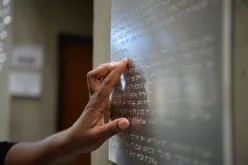The tactile dance of dots beneath fingertips, once a key to unlocking knowledge, has now become a beacon guiding change on global platforms, helping to champion inclusivity and accessibility.
While braille has traditionally been used by people with visual impairment to access, gather, and share information and overcome barriers to information and communication, the UN recognizes the importance of braille as a means of communication in the full realization of human rights for blind and partially sighted people. The UN Convention on the Rights of Persons with Disabilities (CRPD) furthermore recognizes braille as a means of communication to facilitate accessible information sharing and mandates that there are braille signages in public buildings and other facilities.
United Nations Volunteers (UNV) has been engaging volunteers with disabilities, and some of them are people with visual impairments. At UNV, we are committed to building an inclusive and enabling workplace and environment and advancing the rights and well-being of persons with disabilities.
The use of braille also enables people with visual impairment to access written information and be independent in reading and writing. This means a greater equality that allows people with visual impairment to have the same use, power, fluidity, and enjoyment of the written word that sighted people have.
Moreover, the advances in technology have now also led to the development of digital braille. This has further enabled braille use to become an efficient part of everyday life for people with braille literacy.
We spoke to some of our former and serving volunteers with visual impairment on how the use of braille has enabled them in their work or at school.
“The intricate dance of raised dots beneath my fingertips is the key that unlocks the world's knowledge. Before the veil of darkness descended, I couldn't fathom how such tiny bumps could transform my life. Yet, they have become my portal to complex scientific equations, each dot a steppingstone to new understanding. They empower me to craft documents, free from grammatical stumbles, weaving sentences that sing with confidence. And in my current UNDP work, the braille display hums under my touch, each character a beacon guiding me through presentations that ignite change from policymakers. Braille is not just a language; it's the symphony that gives me the power to advocate, to educate, and to dream.” Dao Thu Huong, Disability Inclusion Officer, United Nations Development Programme, Vietnam.
“Since I acquired visual impairment at an early age, I started using Braille for reading and writing. In primary school, I used a Slate and Stylers. But the transition to being able to use both braille and modern, digital technology was more enabling. I used a computer with JAWS screen-reader in combination with an Orbit Reader, a refreshable braille display. While this gave me a flexibility of choosing the device I want to use, it also gave me access to more information as well as freed me from the bulky paper braille documents. I can easily and happily read and write braille but using it in combination with other technologies has given me more avenues.” Thabiso Maslenitsa, Disability Inclusion Officer, Resident Coordinator’s Office, Lesotho.
Through our lens, we witness firsthand the impact of braille on the lives of our dedicated volunteers. Their stories echo the sentiment that braille is not merely a language; it's a symphony of empowerment that promotes the rights of people with visual impairment. The evolution from traditional paper braille to digital braille, combined with mainstream modern technologies, has opened new avenues, providing flexibility and access to a wealth of information.

